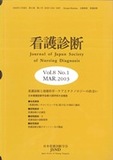Japanese
English
- 有料閲覧
- Abstract 文献概要
- 参考文献 Reference
本研究の目的は,日本におけるNANDA看護診断の使用頻度の実態を明らかにすることであった.324名を対象者として,128のNANDA看護診断の使用頻度を調査した.結果,以下のことが明らかとなった.1)128のNANDA看護診断のほとんどが少なからず広く使用されていた.2)高頻度の診断は,〈感染リスク状態〉,〈不安〉,〈皮膚統合性障害〉,〈便秘〉,〈入浴/清潔セルフケア不足〉の5つであった.3)低頻度の診断は,〈乳児行動統合障害〉,〈レイプ-心的外傷シンドローム〉,〈非効果的セクシュアリティパターン〉,〈ラテックスアレルギー反応〉であった.4)臨床領域別の実態では,専門領域における看護援助の独自性を示す診断が使用されていた.5)使用頻度に影響していることが推測できた要因は看護診断学習の有無であった.
The purpose of this research was to identify the frequency of nursing diagnoses in Japan. The survey of the frequency was conducted using the scale which had one hundred twenty eighth NANDA's Nursing Diagnoses. As a result, these findings were as follows: a) Almost of NANDA's Nursing Diagnoses of one hundred twenty eighth were used slightly, b) There were five NANDA's Nursing Diagnoses which showed high frequency, Risk for Infection, Anxiety, Impaired Skin Integrity, Constipation and Bathing/Hygiene Self-care Deficit, c) There were four NANDA's Nursing Diagnoses which showed low frequency, Disorganized Infant Behavior, Rape-Trauma Syndrome, Ineffective Sexuality Patterns and Latex Allergy Response, d) There were some NANDA's Nursing Diagnoses which showed a specific nursing care according to the clinical setting and e) The frequency of NANDA's Nursing Diagnoses was significantly related to an opportunity of training about Nursing Diagnosis.
Copyright © 2003, Japan Society of Nursing Diagnosis. All rights reserved.


